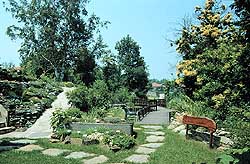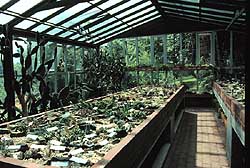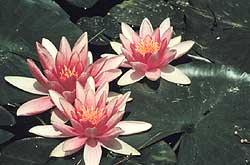|
Il giardino botanico REA

Il giardino botanico REA si trova in Val Sangone, in frazione
San Bernardino di Trana, ad una quota di circa 450 m. È
dedicato a Giovanni Francesco Re, il primo naturalista che ha
compiuto degli studi botanici sulla Val Susa e Val Sangone,
agli inizi del 1800.
Nel 1967 il giardino fu avviato da un collezionista privato,
Giuseppe Giovanni Bellia, come "giardino sperimentale di
acclimatazione per piante alpine ed erbacee perenni".
Nel 1989 fu acquistato dalla Regione Piemonte, e completamente
ristrutturato; la gestione tecnico-amministrativa è affidata
alla Comunità Montana Val Sangone in collaborazione con
il Museo Regionale di Scienze naturali di Torino.
Le colture si estendono su una superficie di circa un ettaro,
su un terreno collinoso, subacido, di origine morenica.
Nel giardino sono coltivati oltre duemila tipi di specie botaniche
provenienti da ogni parte del mondo: alberi, arbusti, piante
acquatiche, grasse, felci, erbe officinali.
Vi è un bosco di latifoglie e un bosco di castagno. Vi
sono tre serre: una didattica, utilizzata per mostre e come
laboratorio, biblioteca e archivio dei semi; la serra tropicale,
la cui temperatura in inverno non scende sotto i 15°, per
felci, orchidee, piante carnivore ed esotiche; la serra per
le succulente, con temperatura di circa 12° e scarsa umidità.
Le piante officinali sono situate in zone diverse: un'aiuola
per le erbe annuali e biennali (prezzemolo, anice, crescione,
camomilla, digitali, ecc.), un terrapieno per le piante mediterranee
(lavanda, timo, rosmarino, ecc.).
Il cespuglieto montano è una piccola area trasformata
in pietraia, per accogliere ontani, rododendri, mirtilli, rovi,
lamponi, piante tipiche della montagna locale che prediligono
il terreno siliceo.
Vi sono inoltre due pietraie, una con grandi blocchi verdastri
di serpentino - tipica della zona di Trana - in cui vivono il
brugo, la calluna, le festuche, e l'altra con massi calcarei
giallastri - tipica delle aride pendici degli orridi di Chianocco
e di Foresto - in cui vivono l'astro alpino e la globularia.
Il giardino è aperto al pubblico dal 2 maggio al 30
settembre; il costo del biglietto è di L. 5.000 per gli
adulti e L. 3.000 per i ragazzi; si può visitare autonomamente
oppure con visita guidata (L. 5.000 a persona per scolaresche,
L. 7.000 per altri gruppi) previo prenotazione; è accessibile
anche ai portatori di handicap; vi è un'area al coperto
destinata al pic-nic, con fontane e servizi.
Per informazioni:
Giardino botanico REA: via Giaveno, 40 - frazione San Bernardino
- 10090 TRANA (TO), tel. 011/933150
Comunità Montana Val Sangone: tel. 011/9376480
Museo Regionale di Scienze Naturali: tel. 011/4323065
|
The REA botanic garden

The REA botanical garden is
situated in Val Sangone in the hamlet of San Bernardino near Trana,
at 450m above sea level. It is dedicated to Giovanni Francesco
Re, the first naturalist who completed botanical studies in Val
Susa and Val Sangone, at the beginning of 1800.
The garden was started in 1967 by the private collector Giuseppe
Giovanni Bella as "experimental garden of acclimatization
for perennial alpine and herbaceous plants". In 1989 it was
acquired by Piedmont Region and entirely restructured. The technical-administrative
management is entrusted to the Val Sangone Mountain Association
together with the Regional Museum of Natural Science of Turin.
The cultivations extend on a surface of approximately a hectare
(2,471 acres) on a hilly acid land of morainic origin.
More than two thousand types of botanical species coming from
every part of the world are cultivated in the garden: trees, shrubs,
aquatic plants, cacti, ferns and officinal grasses. There is a
wood of broadleaf-trees and one of chestnut trees.

There are three greenhouses: a didactic one used for exhibitions,
workshops, library and seeds archive; a tropical one whose temperature
never goes under 15 C for ferns, orchids, carnivorous and exotic
plants; a succulents one with a temperature of approximately 12
C and little humidity. The officinal grasses are planted in various
zones: a flowerbed for the annual and biennial grasses (parsley,
anise, watercress, camomile, etc..) and an earthwork for the Mediterranean
plants (lavender, thyme, rosemary, etc..).
The mountain bush is a small area transformed into a rockery for
alders, rhododendrons, blueberries, raspberries and other typical
local plants that prefer siliceous soil. Moreover there are two
other rockeries: one with great greenish blocks of serpentine
typical of the area around Trana in which grow the heath, the
calluna and the festuche; and the other with yellowish limestone
rocks, typical of the arid slopes of the "orridi" (canyons)
of Chianocco and Foresto, in which live the alpine star and the
globularia.
The garden is open to the public from May 2nd to September 30th.
The entrance ticket is L. 5.000 for adults and L. 3.000 for children.
It can be visited freely or with a pre-reserved guided tour (L.
5.000 each for school groups or L.7.000 for other groups). The
garden has also disabled and picnic facilities.
|